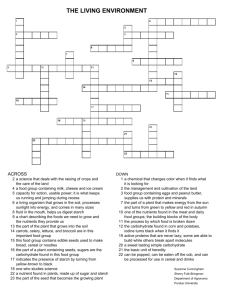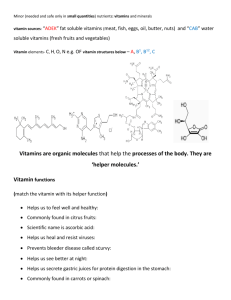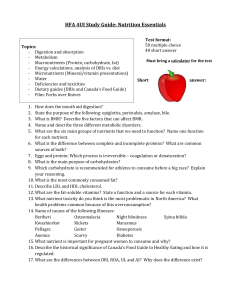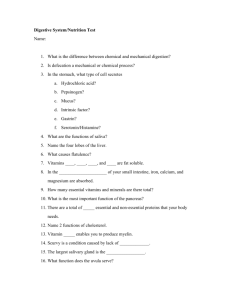•••• STUDIES OF THE RATE OF DIGESTION AND ABSORPTION DURING AVITAMINOSIS
advertisement
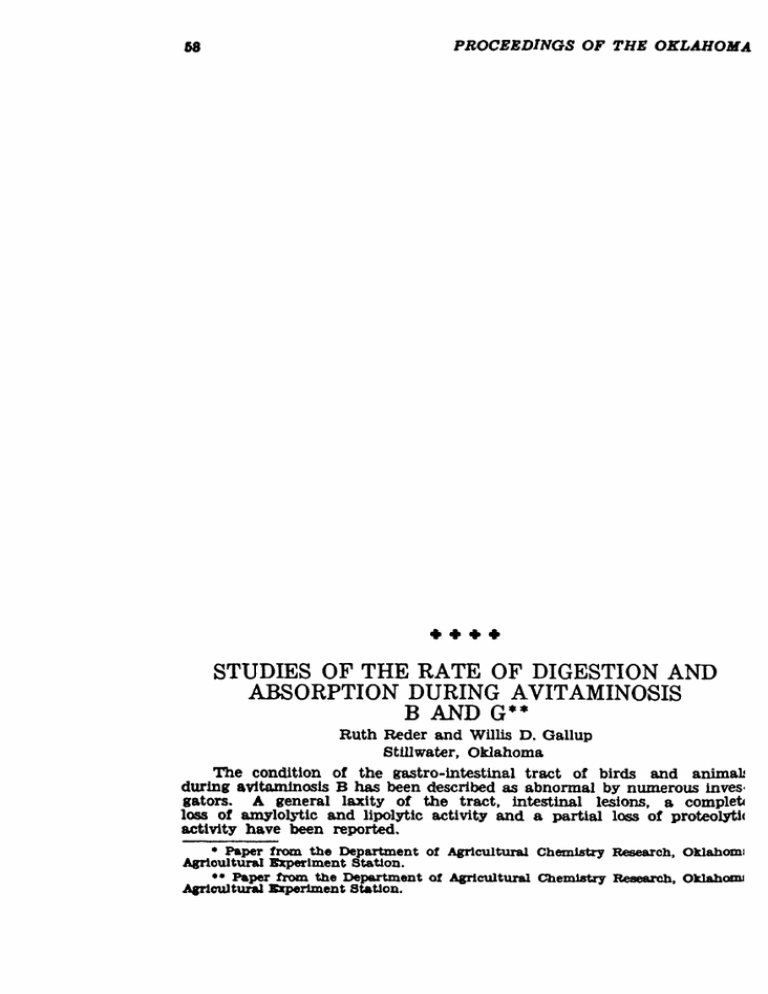
68 PROCEEDINGS OF THE OKLAHOMA •••• STUDIES OF THE RATE OF DIGESTION AND ABSORPTION DURING AVITAMINOSIS B AND G*· Ruth Reder and Willis D. Gallup Stillwater, Oklahoma The condition of the gastro-intestinal tract of birds and animall dW'lng avitaminosis B has been described as abnormal by numerous inves· gators. A general laxity of the tract, intestinal lesions, a complet4 loss of amylolytic and lipolytic activity and a partial loss of proteoIytic activity have been reported. • Paper from the Department of Agrlcultural Chem1stly Research, Oklahoml AarlouItural Experiment Station. •• Paper from the Department of Agricultural Chemistry Research. OklahOlDl AlrtcuJtural Bzpertment Statlon. ACADEMY OF SCIENCE FOR. 1934 69 The possible relationship of vitamin B to carbohydrate metabolism was first suggested by Funk, and in recent years has received considerable attention. Repeated functional analyses haw failed to give convincing evidence of a decrease in the apparent digestibUlty of carbohydrate and protein in pigeons and rats during avitamJ.nosis B. The evidence which has been presented to show that the vitamin B complex influence the rate of absorption of glucose from the gastro-intestinal tract is not convincing. The purpose of the present experiment was to determine the rate of carbohydrate digestion and absorption in rats deprived of either one or both of the vitamins Band G under conditions of controlled food intake. The method of procedure adopted was similar to that outlined by Cori· for studying the rate of a.bsorption of various sugars. Soluble starch was used as a source of carbohydrate and its rate of disappearance from the gastra-intestinal tract was taken as a measure of the rate of the combined processes of digestion and absorption. Because of the small amount of carbohydrate which remained in the tract following digestion periods of suitable length, no attempt was made to differentiate between undigested starch and its hydrolyctic products. The total amount of carbohydrate recovered from the stomach and intestines was determined as glucose. Albino rats of about the same size and approximately two and a half months old were given a basal diet devoid of both the B vitamins until loss of body weight and decreased food consumption indicated that the animals were depleted of these vitamins. Following the depletion period the rats were divided into five groups. The animals of the first group were continued on the deficient diet. Those in the second, third, and fourth groups were given vitamins B, G, and a combination of Band G, respectively. The food consumed by the animals in these three groups was regulated by the food intake of the animals of the first group. The animals of the fifth group received vitamins Band G and were allowed to eat ad libitum. A sixth group was made up of normal animals on a natural diet. Vitamin B was supplied in the form of an alcoholic extract of rice polishings; autoclaved yeast served as the source of vitamin Q. The period of supplement feeding varied from 14 to 21 days. At the end of the period the animals were fasted for 24 hours. Following the fast one mI. of a suspension of soluble starch was delivered into the stomach of the rat by means of a catheter tube attached to the needle of a 1 ml. syringe. The tube and needle were then rinsed with 0.2 ml. of water. The animals were under light ether anaesthesia during the administration of the starch. The amount of starch administered to the rats was determined by delivering an equal volume of the suspension into a beaker in the same manner in which it was introduced into the animal's stomach. The starch was then hydrolized by boiling with HCI and was determined as glucose. At the termination of the period allowed for digestion and absorption, the animal was chloroformed. The gastro-intestinal tract was removed after placing ligatures about the cardiac, pyloric, and lleocoellc sphincters, and the material remaining in the stomach and intestines was recovered by washing the tract with hot water. The washingS were then hydroUzed, neutralized with NaOH and transferred to a volumetric fiask, clarified by the addition of colloidal iron and potassium sulfate, made up to volume and filtered. Aliquots were used for the determinations of glucose by Bertrand's method. Two samples of starch were used. Starch B, which was employed in the first experiments, was found to be digested at a more rapid • COrI, C. P. 1925. J. Bioi. Chem. 88: 691. 80 PROCEEDINGS OF THE OKLAHOMA rate than was Starch M which was used in the latter work. In the preUmlnary experiments two groups containing 81 animals were employed; the flrst group W88 made up of normal animals eating ad libitum; the second group consisted of rats which wera depleted in vitamins Band G. It was observed that the normal animals were able to digesi and absorb carbohydrate at a more rapid rate than were the animals which had been deprived of vitamins B and. G. It should be borne in mind. however. that the depleted a.nirnals differed from the normals not only with respect to vitamin sufficiency but also with regard to their general nutritive condition. The results obtained with Starch M are given in Figure I. Normal rats on a natural diet were able to digest and absorb the starch at a more rapid rate than were the animals of any other group. Animals. (~:ll • Ct5j receiving the basal v" 8((;rAdUJ die t supplemented v".$_.0." 6 with vitamins Band o and eating ad libitum showed a rate only slightly lower than that of animals on a natural diet. In ] both groups digestion 1 was practically com- ~ plete in eight hours. Animals depleted in both vitamins B and G show a retardation in the rate of digestion and absorption during the six-eight TH~ E.rrUT or VITAMIN$ hour period. The i 8 AND G presence of vitamin B ~ UPON THE RATE or OIn"T1oN AND Ae~RPTIOH in the diet faUed to ([ OF produce an increase CAReOHYORATE,) in rate during this period. The addition of vitamin G. however. resulted in a rate equal to that shown by animals receiving both vitamins B and 0 but maintained under condi-' tiona controlled by " , food intake. The effect of the Figure 1. 11mitation of food intake uPOn the rate of digestion and absorption is shown by the fact that animals receiving both vitamins B and G and permitted to eat ad libitum show 9. higher rate than do similar animals on a restricted food intake. SUMMARY Rats deprived of both vitamins B and 0 digested and absorbed carbOhydrate at 9. slower rate than did normal animals. The addition of vitamin B to the diet did not improve the rate. The inclusion of vitamin 0 in ACADEMY OF SCIENCE FOR 1934 81 the diet resulted in a rate equal to that shown by anima.Js on the same nutritive plane but receiving both vitamins Band O. It appears that deprivation of vitamin G and restriction of food intake are responsible for the retardation in the rate of digestion and absorption of carbohydrate observed in animals deprived of both vitamins B and O. ••••



